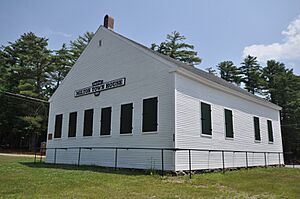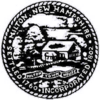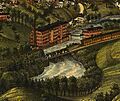Milton, New Hampshire facts for kids
Quick facts for kids
Milton, New Hampshire
|
||
|---|---|---|
|
Town
|
||

|
||
|
||

Location in Strafford County, New Hampshire
|
||
| Country | United States | |
| State | New Hampshire | |
| County | Strafford | |
| Incorporated | 1802 | |
| Communities |
|
|
| Area | ||
| • Total | 34.3 sq mi (88.8 km2) | |
| • Land | 33.1 sq mi (85.6 km2) | |
| • Water | 1.2 sq mi (3.2 km2) | |
| Elevation | 459 ft (140 m) | |
| Population
(2020)
|
||
| • Total | 4,482 | |
| • Density | 136/sq mi (52.4/km2) | |
| Time zone | UTC-5 (Eastern) | |
| • Summer (DST) | UTC-4 (Eastern) | |
| ZIP codes |
03851 (Milton)
03852 (Milton Mills) |
|
| Area code(s) | 603 | |
| FIPS code | 33-48660 | |
| GNIS feature ID | 0873668 | |
Milton is a town located in Strafford County, New Hampshire, in the United States. In 2020, about 4,482 people lived here. Milton is known for its manufacturing, as a resort area, and as a place where people live. It includes the small village of Milton Mills. The main part of town, called the Milton census-designated place (CDP), is found along New Hampshire Route 125 and the Salmon Falls River.
Contents
Milton's Early History and Founding
Milton was first settled around 1760. It was originally part of Rochester and had different names like "Northeast Parish" or "Three Ponds." In 1802, it officially became its own town and was named "Milton." The name might come from "mill town," because of all the mills, or from a person named William Fitzwilliam, who was related to the colonial governors. Another town, Fitzwilliam, is also named after him.
Industries and Businesses in Milton
Because Milton had many rivers and streams, it was a great place for industries that used water power. An engineering company called I W Jones Engineers even set up its offices on Main Street.
In 1893, Jonas Spaulding started a company that made "leatherboard" in Milton. Leatherboard is a material made from recycled leather fibers, often used in shoes. His sons, Leon, Huntley, and Rolland, helped run the business. Huntley and Rolland later became governors of New Hampshire.
The Spaulding family built another leatherboard mill around 1900. They also found a way to make "vulcanized fiber," a very strong and tough material. In 1912, they opened a special factory in New York just for vulcanized fiber. They also bought the Kennebunk Manufacturing Company (KEMACO), which used leatherboard and vulcanized fiber to make things like lunch boxes and violin cases.
Historic Buildings and Architecture
Milton has some unique old buildings. The Milton Town House was built in 1808. The Milton Free Public Library, located in Milton Mills, was once a schoolhouse built in 1875. It has a special architectural style called Second Empire.
Milton's Geography and Location
The main village of Milton is in the southern part of the town. It sits next to the Salmon Falls River, where water flows out of Milton Pond. The village of Milton Mills is about 7 miles north of Milton village.
Major Roads and Rivers
The Spaulding Turnpike (New Hampshire Route 16) runs through Milton from north to south. You can get on or off the turnpike at Exit 17 (near Milton village) and Exit 18 (near the Wakefield town line).
Milton covers about 88.8 square kilometers (34.3 square miles). Most of this is land, with about 3.2 square kilometers (1.2 square miles) being water. The Salmon Falls River flows along the eastern edge of the town, forming the border between New Hampshire and Maine. All the water in Milton eventually flows into the Piscataqua River.
Highest Point and Neighboring Towns
The highest point in Milton is Teneriffe Mountain, which is 1,090 feet (332 meters) above sea level.
Milton shares its borders with several other towns:
- Wakefield (to the north)
- Acton, Maine (to the northeast)
- Lebanon, Maine (to the east)
- Rochester (to the south)
- Farmington (to the southwest)
- Middleton (to the northwest)
Milton's Population and People
| Historical population | |||
|---|---|---|---|
| Census | Pop. | %± | |
| 1810 | 1,005 | — | |
| 1820 | 1,232 | 22.6% | |
| 1830 | 1,273 | 3.3% | |
| 1840 | 1,322 | 3.8% | |
| 1850 | 1,629 | 23.2% | |
| 1860 | 1,862 | 14.3% | |
| 1870 | 1,598 | −14.2% | |
| 1880 | 1,516 | −5.1% | |
| 1890 | 1,640 | 8.2% | |
| 1900 | 1,625 | −0.9% | |
| 1910 | 1,542 | −5.1% | |
| 1920 | 1,428 | −7.4% | |
| 1930 | 1,206 | −15.5% | |
| 1940 | 1,279 | 6.1% | |
| 1950 | 1,510 | 18.1% | |
| 1960 | 1,418 | −6.1% | |
| 1970 | 1,859 | 31.1% | |
| 1980 | 2,438 | 31.1% | |
| 1990 | 3,691 | 51.4% | |
| 2000 | 3,910 | 5.9% | |
| 2010 | 4,598 | 17.6% | |
| 2020 | 4,482 | −2.5% | |
| U.S. Decennial Census | |||
In 2010, there were 4,598 people living in Milton. There were 1,800 households, which are groups of people living together in one home. Most people in Milton (about 97.4%) were white. A small number of people were from other racial backgrounds. About 0.9% of the population identified as Hispanic or Latino.
About 22.9% of the people in Milton were under 18 years old. The average age of people in town was 41.3 years.
Places to Visit and Explore
- New Hampshire Farm Museum: This museum teaches visitors about farming history in New Hampshire.
- The Milton Free Public Library (MFPL) in Milton Mills: This library is in a building that was a school from 1875 until 1991. The library moved into this larger building in 1992. Before that, the library was in a building that is now the historical society, which was built in 1916.
Famous People From Milton
Milton has been home to several notable individuals:
- Louise Bogan (1897–1970): A famous poet who was the fourth Poet Laureate to the Library of Congress.
- Robert Edmond Jones (1887–1954): A well-known theatrical designer.
- Alonzo Nute (1826–1892): A US congressman.
- Richard Olney II (1871–1939): A US congressman from Massachusetts.
- Michael Stonebraker (born 1943): A computer scientist.
Images for kids
See also
 In Spanish: Milton (Nuevo Hampshire) para niños
In Spanish: Milton (Nuevo Hampshire) para niños










